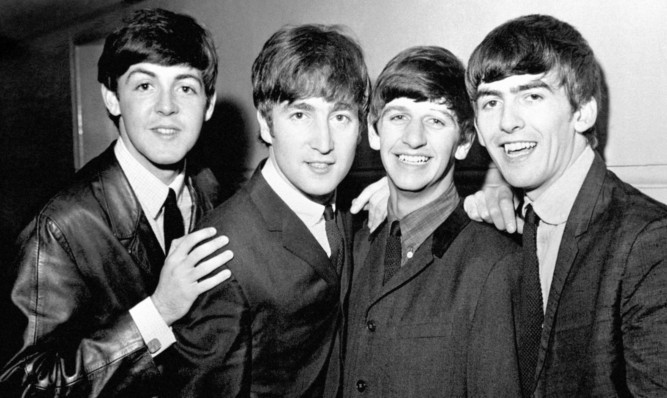
It’s the richest treasure trove of classic songs ever written but there are still new tales to be found of how The Beatles came to write their fabulous music.
A new book, All Together Now, is the result of an incredible 20 years’ analysis by Fabs fanatic David Rowley, and he’s somehow managed to shed new light on the most famous pop ever heard.
David covers every song The Beatles ever wrote and plenty they didn’t and he shows that, with this group, things were seldom how they seemed!
For a man who has married three times, it comes as a surprise to learn just how many of Sir Paul McCartney’s classics were inspired by his love for Jane Asher, the girl he didn’t wed.
Still an elegant woman today, in the 1960s, Jane was an incredibly beautiful, artistic, much-fancied star herself, and some reckon Macca was in awe of her.
According to the book, one of his most intriguing songs, For No One, is centred on Paul’s fall-out with Jane during a skiing holiday they went on in Switzerland.
This was several years into their relationship, and he refers to love being dead and to a lady who is always going out while he stays in, and vice versa.
Maybe listening to these classics again tells us more about our heroes than they’d like us to know!
Another McCartney classic, Martha My Dear, is also reckoned to be about Jane Asher, although parts of it were inspired by the other “girl” in his life.
A giant sheepdog by the name of Martha was the pride of Paul’s heart at that time, but the strange song has intrigued musicians since the day it was released.
That’s because it is very, very hard to play! Paul used the piano part in this tune as an exercise to improve his playing, and to this day even fine pianists find it incredibly difficult.
When people tell you Paul was an all-round genius, they are really not exaggerating!
You may have heard how he woke up one morning with the complete melody of Yesterday in his head, and assumed he must have heard it somewhere else. In fact, it was a complete original.
But it’s been unknown until now that when he wrote the song Blackbird, he’d wake up to hear a real blackbird outside his window whistling his tune back.
It seems he’d played it so often indoors, the bird had picked up the tune months before the public got to hear it.
John Lennon, as the book reveals, was feeling far less confident in his musical abilities by 1968. While Paul had fantastic new tunes pouring out every few days, John felt the complicated Sergeant Pepper album had shown up his weaknesses.
So he was angry when the recording of that year’s White Album began, and demanded the four musicians perform their new songs “live”.
He’d gone on their famous trip to India with wife Cynthia, but thought constantly of Yoko Ono, and his songs came out full of anger and frustration or of secret love songs to Yoko.
As the four of them got on each other’s nerves, John was voted down, and much of the album was recorded with Paul in one room doing his songs, John in another, and Ringo even walked out and went on holiday.
Within a couple of years, when Paul told John he wanted to finally go back out on tour, John told him, “I want to quit” and the band broke up.
George Harrison, also in a studio room by himself, had always struggled to make his fellow-Beatles take his songs seriously.
In fact, he was so angry when they didn’t give their approval to While My Guitar Gently Weeps, that he asked his pal Eric Clapton to play on it.
“Suddenly,” George recalled, “everybody was on their best behaviour!” Clapton played a great guitar part, but the real beauty of the song only emerged when a never-heard-before version appeared.
George had done this version with just an acoustic guitar, and it seems it wasn’t just his guitar that wept John and Paul’s treatment led him to the verge of tears during the verses.
They were certainly taking him seriously when he wrote Here Comes The Sun, but the book shows a new inspiration behind it. Britain was going through amazing freak weather conditions at the time!
Every generation enjoys When I’m 64, but most are unaware how it came about. In The Beatles’ early days at the Cavern Club, the electricity would often conk out.
The only thing that didn’t need plugging in was the bar piano, and Paul would entertain them with this little ditty until a few coins were put in the meter.
Speaking of bar pianos, Sir George Martin played an unlikely role for Rocky Raccoon. Another McCartney number, Paul wanted it to have a Wild West saloon feel.
He sings it in a mock cowboy accent, with John playing an old Wild West-style harmonica and Sir George, the man behind their orchestral arrangements, did a stunningly-good impersonation of a barroom piano player!
Of all David’s intriguing stories, though, are the ones that got away, and we’re talking about songs, not Paul’s girlfriends.
If You’ve Got Trouble, he reveals, was so bad that Ringo Starr passed on the chance to do it, actually sabotaging the recording to get out of it!
Unbelievably, it wasn’t their only stinker heartening, somehow, to think even The Beatles could write a song that wasn’t a guaranteed hit.
All Together Now, the ABC of The Beatles’ Songs and Albums, is out now, published by Matador, price £9.99.

Enjoy the convenience of having The Sunday Post delivered as a digital ePaper straight to your smartphone, tablet or computer.
Subscribe for only £5.49 a month and enjoy all the benefits of the printed paper as a digital replica.
Subscribe